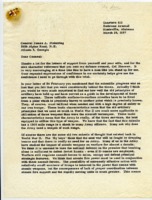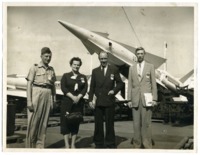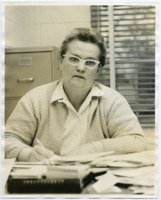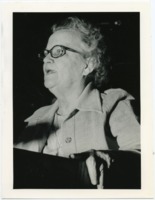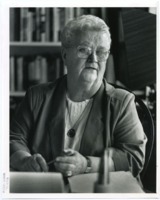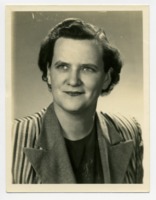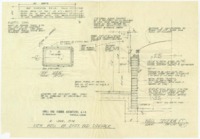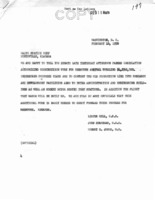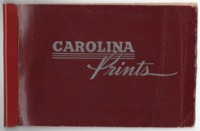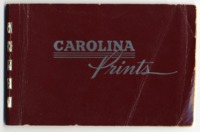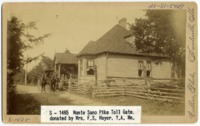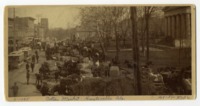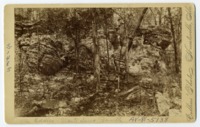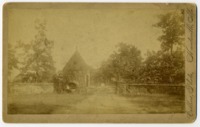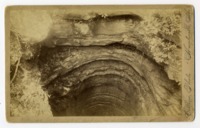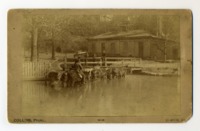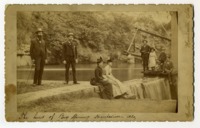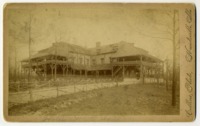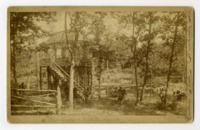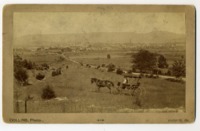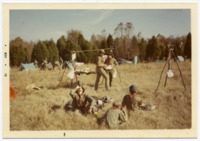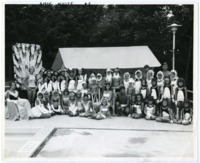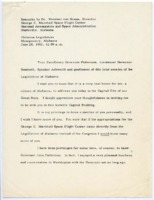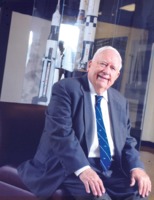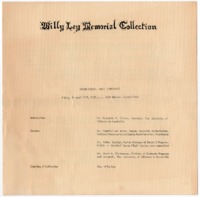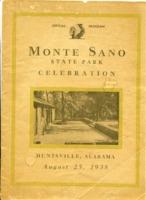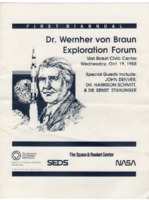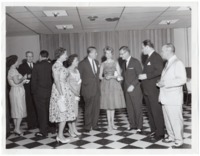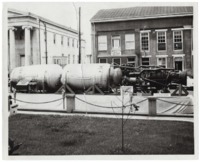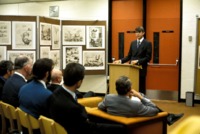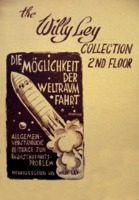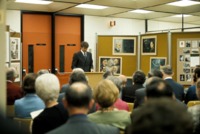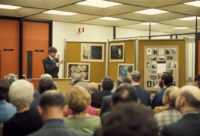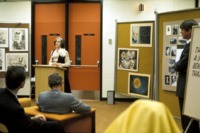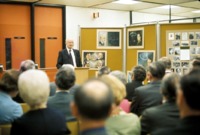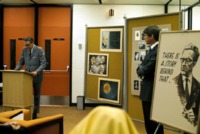
Browse Items (2077 total)
Sort by:
-
Abbreviated timeline of the Apollo 11 mission.
The timeline includes a memorandum from Friedjof A. Speer, manager of the Missions Operations Office, to employees of Marshall Space Flight Center. Speer notes that "astronaut Neil Armstrong is scheduled to be the first man to step onto the moon's surface." The timeline outlines the entire mission from liftoff at 8:32 AM on Wednesday, July 16, 1969 to splashdown at 11:49 AM on Thursday, July 24, 1969. -
Letter from Col. John C. Nickerson at Redstone Arsenal in Huntsville, Alabama, to Gen. James A. Pickering in Atlanta, Georgia.
In this letter, Nickerson thanks Gen. Pickering for his support and explains why he believes the Army is the best service branch to develop ballistic missiles. He also discusses the need for missiles in case of war with the Soviet Union. Nickerson was a staff officer at the Army Ballistic Missile Agency at Redstone Arsenal assigned to work on the Jupiter, the United States' first mid-range ballistic missile. He was arrested and court martialed for espionage in 1957 after releasing sensitive documents about the United States missile program to the press. At the time, Secretary of Defense Charles E. Wilson granted the Air Force sole authority to develop intermediate range ballistic missile systems. Nickerson disagreed with this policy, and in response, leaked documents that demonstrated the superiority of Army missiles compared to those developed by the Air Force. He eventually pled guilty to lesser charges and was suspended from the Army for one year and was fined $1,500. Dr. Wernher von Braun was among those who testified on Nickerson's behalf. -
Photo of Frances C. Roberts.
Photo from the Huntsville Times. The photo was taken for an article about the honorary doctor of humane letters that Roberts received from UAH on December 12, 1993. -
Drawings of a sidewalk well and rail on Courthouse Square in downtown Huntsville, Alabama.
The drawings include plans for a building a well in the sidewalk with a glass top for viewing the "old handmade brick walk" underneath the current sidewalk. In one of the notes, architect Harvie P. Jones notes that the historic sidewalk probably dates from the early to mid-nineteenth century "based on its depth of approximately 10" below the present walk." The well is located in front of 205 East Side Square. It was restored in 2018. -
Letter from Sen. Lister Hill, Sen. John Sparkman, and Rep. Bob Jones to Huntsville radio stations.
Addressed to stations WBHP and WFUN, the letter announces that the U. S. Senate passed "legislation authorizing construction work for Redstone Arsenal totaling $4,250,000." The letter also mentions building rocket test stations and a flight test range. -
Photo album of downtown Huntsville from the city's sesquicentennial celebration.
The album includes photos of the Confederate monument and banners and decorations on the street. -
Photo album of downtown Huntsville from the city's sesquicentennial celebration.
The photos show scenes from the sesquicentennial festivities in and around the square, including people dressed in early nineteenth century attire, storefronts, and street decorations. -
"Cotton Market, Huntsville, Ala."
The photo shows the north side of courthouse square looking east in downtown Huntsville. The Madison County Courthouse can be seen at the right of the photo. -
"Entrance to Shelta Caverns."
The photo shows the owner, Henry Fuller, with his family outside the cave entrance. Fuller purchased the cave in 1888 and developed it into an underground dance hall and bar. The cave is near current-day Pulaski Pike in Huntsville. -
"The Eddies -- Monte Sano Ramble."
The photo depicts a man sitting on the rocks amidst the trees. The back of the photo reads, " 'The Eddies' or Eddy Rocks of Monte Sano." -
"Entrance to O'Shaughnessy Place -- Monte Sano."
The O'Shaughnessy Place, nicknamed "Castle Delight," was built in 1885 by Col. James and Lucy O'Shaughnessy. It was a two-story Queen Anne-style house with four chimneys, gas lights, water lines, and indoor plumbing. Col. O'Shaughnessy was a cotton and real estate broker, seaport and railroad developer, and co-owner of the Huntsville Hotel, Huntsville Opera House, Hotel Monte Sano, and the Monte Sano Railway and Turnpike. The house burned in March 1890 and was demolished in the 1920s. -
"Natural Wells. 350 ft drop in solid rock -- Monte Sano."
The well is a large limestone cave shaft located near the site of the Hotel Monte Sano. -
"Hotel Monte Sano."
The hotel opened on June 1, 1887 as a luxury health resort. It was built by the North Alabama Improvement Company with funding from Michael and James O'Shaughnessy. The hotel closed in 1900 and was demolished in 1944. -
"Lilly Lake -- Monte Sano."
This photo shows a scene at Lily Lake on the grounds of Col. James O'Shaughnessy's home on Monte Sano. According to the Historic Huntsville Quarterly, the structure in the foreground of the photo is a "four-tiered vertical framework covered with ivy, and reaching an impressive height of twelve feet or so." -
"The Valley of Huntsville."
The view shows Athens Pike (now Holmes Avenue) in Huntsville, Alabama, with Monte Sano Mountain in the background. -
Topographical map of Monte Sano.
This map was drawn by William W. Varnedoe, Jr. and published by the Monte Sano Civic Association. It shows Monte Sano's neighborhoods, the state park, and the mountain's natural features, including springs and caves. The map also notes changes in elevation. -
Transcript of a speech given by Wernher von Braun to the Alabama Legislature.
Von Braun, then the director of Marshall Space Flight Center in Huntsville, Alabama, delivered this speech to the legislature in 1961. In the speech, he emphasizes that Alabama must take advantage of its position in the aerospace industry and create a robust "academic and research environment" in Huntsville to attract businesses that "will give birth to major new industries throughout the state." He exhorts the legislature to fund the newly established University of Alabama Research Institute (now part of the University of Alabama in Huntsville), arguing that "the Institute will not only be self-sustaining, but will enrich the State both financially and culturally." The legislature later approved von Braun's request of $3 million for the Research Institute, enabling the purchase of 200 acres of land for the campus and the construction of the Institute in 1964. The speech includes copies of slides von Braun used during his presentation, including diagrams of Saturn and Nova rockets as well as a mockup of a Saturn rocket on the lawn of the state capitol in Montgomery. -
Transplanted Rocket Pioneers.
The information in this dataset is reproduced from Charles Lundquist's 2014 monograph Transplanted Rocket Pioneers. The information includes biographical and professional information that he compiled to produce the book. Each individual represented in the dataset also has a vertical file in the Lundquist Collection at UAH.
Transplanted Rocket Pioneers is a recognition of the early members of the von Braun rocket team, many of whom were key players in the successful moon landing. Many historians conclude that the lunar missions of the Apollo Program could not have been possible without the leadership and experience provided by a corps of engineers, scientists and managers transplanted from Europe to the Unites States after World War II. This fact motivated Dr. Lundquist to deposit this work in the Archives of the Library at the University of Alabama in Huntsville by assembling a file on each of the individuals who came from Europe to participate in the rocketry activities in Huntsville, or, in a few cases, individuals who had other ties to Huntsville.
This dataset includes a standard one-page summary sheet for each subject. Although most sheets are relatively complete, some data are still missing.
The first two lines on each page records fundamental identification information:
Family name Date of birth Place of birth Given names Date of death Place of death
The next standard entry is a statement of the extent of the Archives Holdings, either i) A primary collection of documents housed in one or more banker boxes, usually a separate individual collection ii) A secondary collection in a standard archive box, or iii) a file folder. Next, if there is an oral or video history for the individual, this fact is noted. A statement about the highest education levels of the individual follows. The next five entries, in chronological order, record whether the individual participated in activities at five sites:
1. Raketenflugplatz-Kummersdorf: Individuals engaged in the activities at these sites of early rocket development experiments sponsored first by VfR and subsequently by the German Army.
2. Peenemünde: Included here are individuals who participated in Peenemünde programs under several auspices, including as Army civilian employees, as members of the German military, as contractor employees on site or visiting as needed, and as university employees collaborating as required.
3. Fort Bliss: Individuals who were brought to Fort Bliss from 1945 to 1950.
4. GMDD-ABMA: Individuals who came to Huntsville, Alabama to work for the US Army rocket programs in the decade 1950 to 1960.
5th MSFC: Individuals who were employed by the NASA Marshall Space Flight Center in the 1960s.
Some people had various relationships with UAH and that is so noted. Additionally, a statement of immigration details is noted if pertinent. Finally, a great variety of incidental information is included under Incidental Remarks.
UAH Special Collections welcomes additions of biographical materials to the vertical file in the Charles Lundquist Collection. Please note that the work is that of Dr. Lundquist and may contain errors or omissions which are solely the product of his work on the project, as noted in the introduction of the work.: " Finally, it is pertinent to note that any document containing large files will surely have some mistakes or omission. Any errors are the responsibility of the author alone." As was the wish of Dr. Lundquist, we will strive to make factual corrections to the online copy when necessary.
-
Charles Lundquist at the University of Alabama in Huntsville.
Charles A. Lundquist seated in Von Braun Research Hall, at the University of Alabama in Huntsville. -
Program from the dedication and opening of the Willy Ley Memorial Collection at the UAH Library.
The program includes a diagram of the arrangement of the collection, a brief biographical sketch of Ley, and a program for the "Ley Memorial Symposium on Science and Technology in the 1970's." Willy Ley died in 1969. The UAH Library purchased his book collection from his widow, Olga Ley, in 1970. -
Official program of the Monte Sano State Park Celebration.
This celebration was held on the park's opening day. Events included a parade, an address given by Speaker of the U.S. House of Representatives William B. Bankhead, a history pageant, and a "Queen's Ball" that evening at the Russel Erskine Hotel. The program includes a description of the cabins, the "Legend of Monte Sano," a history of Huntsville, and a program for the history pageant, titled "The Parade of Progress." -
Program from the first biannual Dr. Wernher von Braun Exploration Forum.
The forum included a scholarship presentation and awards dinner given by the National Space Club. Special guests were musician John Denver, Apollo 17 astronaut Harrison Schmitt, and engineer Ernst Stuhlinger. -
Wernher and Maria von Braun at a cocktail party given for the Alabama legislature.
A note on the back of the photo reads, "Cocktail Party for legislature at time Huntsville wanted Research Park & Institute for university." From left to right: Mrs. Foster Haley, Mrs. Milton Cummings, Wernher von Braun, Maria von Braun, Roscoe Roberts, Ryan DeGraffenried, and Milton Cummings. -
Parts of a V-2 rocket on display on the west side of Courthouse Square in Huntsville, Alabama.
The tank on the left is labeled "V-2 Alcohol Container," while the tank on the right is labeled "V-2 Liquid Oxygen Container." On the far right of the photo is the "V-2 Propulsion Unit." In the background are various businesses, including P. M. Woodfin Cotton, Anderson Clayton & Co. Cotton Buyers, and First National Bank. -
David Christensen speaking at the dedication of the Willy Ley Collection at the UAH Library.
Christensen then worked in the Division of Graduate Programs and Research at UAH. The UAH Library purchased the Willy Ley Collection from Ley's widow, Olga, in 1970. -
Painted sign advertising the Willy Ley Collection at the UAH Library.
Today this sign is on display in the Archives and Special Collections reading room on the ground floor of the library. The UAH Library purchased the Willy Ley Collection from Ley's widow, Olga, in 1970. -
David Christensen speaking at the dedication of the Willy Ley Collection at the UAH Library.
Christensen then worked in the Division of Graduate Programs and Research at UAH. The UAH Library purchased the Willy Ley Collection from Ley's widow, Olga, in 1970. -
David Christensen speaking at the dedication of the Willy Ley Collection at the UAH Library.
Christensen then worked in the Division of Graduate Programs and Research at UAH. The UAH Library purchased the Willy Ley Collection from Ley's widow, Olga, in 1970. -
Olga Ley speaking at the dedication of the Willy Ley Collection at the UAH Library.
David Christensen is standing at the right. The UAH Library purchased the Willy Ley Collection from Mrs. Ley in 1970. -
Arthur Rudolph speaking at the dedication of the Willy Ley Collection at the UAH Library.
At the time, Rudolph was retired from NASA as the former manager of the Saturn V program at Marshall Space Flight Center. The UAH Library purchased the Willy Ley Collection from Ley's widow, Olga, in 1970. -
Ben Graves speaking at the dedication of the Willy Ley Collection at the UAH Library.
Graves was the president of UAH at the time. David Christensen is standing at the right, next to a sign painted to advertise the collection. The UAH Library purchased the Willy Ley Collection from Ley's widow, Olga, in 1970.

